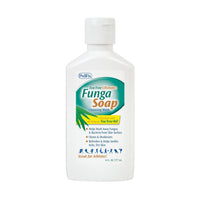Description
 Athlete's foot is the layman's term used to describe two different fungal infections of the foot. The medical term for athlete's foot is tinea pedis. Tinea refers to the causative organism, and pedis refers to the location of the infection. The two fungal organisms we see most often are trichophyton rubrum (chronic) and trichophyton mentagrophytes (acute.) Trichophyton rubrum, or chronic athlete's foot, is often mistaken for dry skin and is the most common organism found in low-grade chronic fungal infections. Acute athlete’s foot, caused by trichophyton mentagrophytes, is characterized by bubbles, blisters, and itching. Both organisms cause inflammation in the skin that leads to itching.
Athlete's foot is the layman's term used to describe two different fungal infections of the foot. The medical term for athlete's foot is tinea pedis. Tinea refers to the causative organism, and pedis refers to the location of the infection. The two fungal organisms we see most often are trichophyton rubrum (chronic) and trichophyton mentagrophytes (acute.) Trichophyton rubrum, or chronic athlete's foot, is often mistaken for dry skin and is the most common organism found in low-grade chronic fungal infections. Acute athlete’s foot, caused by trichophyton mentagrophytes, is characterized by bubbles, blisters, and itching. Both organisms cause inflammation in the skin that leads to itching.
Fungus, or the plural fungi, are non-flowering plants that lack chlorophyll. Fungi are very sensitive to their environment and thrive in a damp and dark environment. Lacking chlorophyll, fungi can't synthesize their own food and therefore have to live off of other organic material. In the case of athlete's foot, the tinea organism is actually living off of the dead skin cells of our foot.
Athlete's foot is known to infect 15% of the world's population, affecting 1 in 5 adults. (1,2)
Causes and Contributing Factors
Warmth and moisture promote fungus growth. Non-breathable shoes and excessive perspiration contribute to acute and chronic fungal infections.
Treatment
When treating fungal infections of the foot it's important to understand and differentiate between bacterial and fungal infections. Bacterial infections are a finite problem, meaning that you can cure most bacterial infections with an antibiotic in a brief period of time. A good example would be the treatment of strep throat with penicillin. A 10-day course and the strep infection is cured. A fungal infection of the foot cannot be cured and must be treated differently. You need an ongoing plan if you intend to control athlete's foot.
strep throat with penicillin. A 10-day course and the strep infection is cured. A fungal infection of the foot cannot be cured and must be treated differently. You need an ongoing plan if you intend to control athlete's foot.
Oral fungal medications used to treat fungal infections of the skin and nail have become popular over the past several years. Medications such as Lamasil and Sporanox can be used successfully to treat an acute fungal infection, but these medications will not provide a long-term prevention of recurrence. The cost and side effects  of these medications are significant. Oral medications simply can't be looked upon as a cure for athlete's foot infections. Therefore, if you choose an oral medication, remember you will need to continue using a topical anti-fungal medication once the oral medicine is discontinued.
of these medications are significant. Oral medications simply can't be looked upon as a cure for athlete's foot infections. Therefore, if you choose an oral medication, remember you will need to continue using a topical anti-fungal medication once the oral medicine is discontinued.
Some of the traditional methods used to treat tinea pedis infections are simple and effective. For instance, eliminate the dark, warm and damp environment where fungi thrive. Create an environment in the shoe that is cool, dry and accessible to ultraviolet light. Following these simple suggestions can dramatically change the course of a fungal infection:
-
Rotate your shoes every other day to allow them to dry thoroughly.
-
Avoid synthetic materials like rubber or vinyl. Wear leather or cloth that can absorb moisture.
-
Change your socks frequently to wick away moisture.
-
Using talc or baby powder daily also helps wick away moisture.
-
Use an over-the-counter antifungal or antiseptic soap or antifungal lotion.
A severe case of acute athlete's foot may require prescription-strength topical antifungal creams or lotions. A variety of creams and lotions are available from your drugstore or doctor. In limited cases where a fungal infection is quite severe, we may even use an oral antifungal, but these cases are unusual.
Differential Diagnosis
The differential diagnosis for fungal infections of the foot includes:
Cellulitis
Dermatitis
Eczema
Psoriasis
Skin tumors of the foot
Toe box dermatitis
When to Contact Your Doctor
Fungal infections that fail to respond in two weeks to topical, over-the-counter medications should be evaluated by your podiatrist or primary care physician.
References
1. Bell-Syer, SE; Khan, SM; Torgerson, DJ (17 October 2012). "Oral treatments for fungal infections of the skin of the foot". In Bell-Syer, Sally EM. The Cochrane database of systematic reviews 10: CD003584.
2. Havlickova, B; Czaika, VA; Friedrich, M (September 2008). "Epidemiological trends in skin mycoses worldwide". Mycoses 51 (Supplement 4): 2–15.
Author(s) and date
 This article was written by Myfootshop.com medical advisor Jeffrey A. Oster, DPM.
This article was written by Myfootshop.com medical advisor Jeffrey A. Oster, DPM.
Competing Interests - None
Cite this article as - Oster, Jeffrey. Athlete's Foot. https://myfootshop.com/article/athletes-foot
Most recent article update - November 11, 2020.
 Athlete's Foot by Myfootshop.com is licensed under a Creative Commons Attribution-NonCommercial 3.0 Unported License.
Athlete's Foot by Myfootshop.com is licensed under a Creative Commons Attribution-NonCommercial 3.0 Unported License.
Internal reference only: ZoneP7, ZoneD8, ZoneL12, ZoneM10






